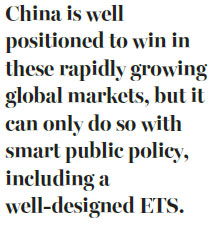Carbon market leads to sustainable growth

China's efforts will help domestic enterprises develop the expertise needed to become more competitive in global markets
With China set to launch an emission trading system nationwide to reduce carbon dioxide output, its policymakers could learn a thing or two from California's successful experience. It suggests the ETS will help China achieve sustainable growth.
Many may question how an environmental policy can help generate sustainable economic growth. The answer is three ways.
First, imposing a price on carbon emissions will help achieve President Xi Jinping's goal of more efficient economic allocation through market signals.
Second, reducing greenhouse gases such as carbon dioxide will improve the quality of air, so the carbon market will help create more blue-sky days in China, which means better performance from both blue-collar and white-collar workers.
And third, as the rest of the world increasingly embraces clean technologies, China's efforts will help domestic enterprises develop the expertise needed to become more competitive in global markets.
Carbon reductions have proved to be easier to accomplish and more beneficial than expected in economic and social terms in the European Union, the Scandinavian countries and California.
California has shown that carbon pricing can coexist with strong economic growth. The US state has the highest ETS price in the world - more than twice the EU price - along with the strongest overall economic growth in the Western hemisphere.
Also, California's robust ETS price has unleashed innovation and attracted new investment. It leads other US states in clean technology investment and patents, and regularly attracts the most clean-tech venture capital investment in the US. Last year, California attracted $1.4 billion in clean-tech venture capital, accounting for two-thirds of the total venture capital in the United States.
Since its ETS went into effect in 2012, California's job creation rate has been 50 percent higher and economic growth twice as fast as the US national rate. And among these jobs, more than 500,000 have been created in the clean-energy industry, including more than 150,000 in the solar power sector.

The effects of the ETS on energy prices have been almost imperceptible. Since gas prices are determined more by global oil prices than the carbon market, diesel costs less in California today than what it did when the ETS went into effect, because of lower international prices.
A reduction in pollution means an improvement in air quality, which is just one of the benefits of fighting climate change. This was aptly explained by Xie Zhenhua, China's special representative on climate change issues:
"The cause of air pollution and climate change is the same - the burning of fossil fuels. Many of the policies and measures to solve the two issues are the same, such as reducing coal consumption and controlling the number of motor vehicles."
Moreover, statistics help convey the opportunities offered by the surging global clean technology markets. Renewable electricity generation technologies have attracted more new investment globally than fossil fuel technology since 2011.
Last year, renewable energy technologies accounted for 70 percent of the new power plants that were set up, attracting more than $200 billion in new capital investment. Battery energy storage and electric vehicles appear poised to make similar spectacular gains.
Bloomberg New Energy Finance predicts that by 2030 half of new sales will be battery-driven electric vehicles, and The Economist has called the internal combustion engine "roadkill", suggesting that "the end is in sight for the machine that changed the world".
As the world's leader - in installation and manufacturing of solar power, wind power, and electric vehicles - China is well positioned to win in these rapidly growing global markets, but it can only do so with smart public policy, including a well-designed ETS.
The author is Energy Innovation's research director. The views on this page do not necessarily reflect those of China Daily.
(China Daily European Weekly 09/22/2017 page13)
Today's Top News
- Expert debunks Lai's 'four elements' argument for Taiwan's so-called statehood
- China opposes any tariff deal made at its expense: commerce ministry
- Nepal's hydropower a climate change solution
- UN Charter still guiding compass of humankind
- Leaders pledge to strengthen Sino-Senegalese relations
- China, Ecuador to support each other's core interests






























